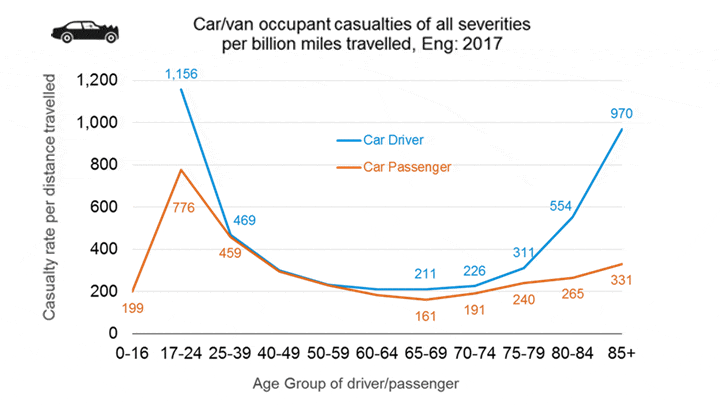
Proposals that were due to be discussed on 16th May 2023 could mean that new drivers under the age of 25 will be banned from carrying passengers for up to a year after passing their driving tests.
At the time of writing, the proposed date for the discussion has passed but we have not yet seen any reports of its conclusions.
The ban is being considered as a measure aimed at reducing the number of accidents and fatalities involving younger drivers soon after passing their tests. The proposal, which forms part of government plans for a 'graduated driving licence' has the approval of road safety campaigners and accident victim support groups. The origin of the steps being considered is a 69-page government document called the Road Safety Statement, which came out in 2019.
The reasoning
Logically enough, the government points to accident statistics for justification and their Road Safety Statement shows the following chart showing accident casualties by age.

Source: Department for Transport Road Safety Statement 2019 (PDF)
The 17-24 age group certainly does stand out as a problematic demographic so far as casualty figures are concerned, but is it that simple?
Leave those kids alone
Research conducted by ALA Insurance found that in 2017, the same period examined in the government's chart, 26.12% of new drivers aged 18 - 24 admitted to having an accident in their first 12 months of driving, while 27.7% of new drivers aged 25 - 34 admitted having an accident in the first year. If ALA's sample is representative of the wider new-driver population, then under-25s are not the new-driver age group most prone to first-year accidents.
Understandably, some young people will feel persecuted and will wonder why they are being singled out for restriction when the 25 - 34 group, who had more accidents in the research period, are not being considered for similar measures.
It is also worth noting that the government chart featured in the Road Safety Statement takes into account all drivers and not just the newly qualified, whereas the ALA survey concentrated on new drivers and may, arguably, be considered a more relevant indication of which new-driver demographic presents the greatest risk.
Over the hill
The 2019 Road Safety Statement didn't just single out younger drivers for attention; the safety record of older drivers was also highlighted as an area of concern. Indeed, the statement acknowledged that the accident rate amongst young drivers had decreased quicker than that amongst older motorists.
The curve in the chart above clearly indicates that risk increases again with age. If action is required to reduce the number of accidents among young people, then it is hard to deny that equivalent measures of some suitable nature may need to be introduced for older motorists.
Risk factors
The factors that contribute to accidents involving young drivers and those contributing to accidents involving older drivers are obviously different. These risk factors must be examined as thoroughly as accident figures themselves if effective steps are to be taken.
Risk factors affecting young drivers
-
Inexperience
Motorists who have been driving for a long time develop reactions through repetition and familiarity. Certain reactions, such as steering manoeuvres and braking, get programmed into muscle memory and become second-nature in common circumstances. New drivers, on the other hand, haven't had the time or experience to allow them to develop these instincts. They have to analyse novel situations and often make decisions for which they may have no personal precedent. These elements can lead to delay in action that might avoid an accident.
-
Overconfidence
Having recently successfully completed a test of their driving capabilities, a young driver may feel well-equipped to deal with whatever they may encounter on the roads. Unfortunately, lessons and examinations can only cover a fraction of what may happen in the real world. Overconfidence can lead people to drive faster and pay attention less closely to the road around them. As we have seen above, when the unexpected happens, new young drivers often lack the experience and reflexes to deal with it safely.
-
Risk-taking behaviour
Young drivers are more likely to indulge in potentially dangerous behaviour than older drivers for whom the novelty of driving has worn off. Young drivers often enjoy elevated social standing and credibility by being a car driver and being able to take their friends to places. Unfortunately, there is also temptation to show off, including by driving too fast, doing tricks or stunts or other behaviour that means 100% of their attention is not on driving safely.
-
Recreational drug and alcohol use
According to Office for National Statistics data for the year ending June 2022, showed:
'Approximately 1 in 11 adults aged 16 to 59 years (9.2%; approximately 3 million adults) and approximately 1 in 5 adults aged 16 to 24 years (18.6%; approximately 1.1 million adults) reported last year drug use in the year ending June 2022.'
This shows a higher incidence of drug use amongst the younger group. Similarly, men aged 16-24 are amongst the biggest users of alcohol. Perhaps surprisingly, women in the same age range are amongst those using the least alcohol. Regardless of the level, any amount of a substance that can impair one's faculties can contribute to an accident, especially if it is combined with one or more of the other risk factors mentioned here.
Risk factors affecting older drivers
-
Slower reflexes and thinking
A sad fact of life and fairly self-explanatory.
-
Confusion
Conditions such as dementia can begin to affect behaviour and competence to drive long before a formal diagnosis is obtained. Again, for some people this will be an unwelcome feature of advancing age.
-
Illness
Older people do begin to suffer a higher incidence of illness and injury. Some of these will inevitably impact their performance as drivers.
-
Prescription drug use
Largely a consequence of the previous factor in this list. Older people may feel less inclined to consume cannabis or cocaine but they are more likely to take a variety of prescription medicines, some of which can affect their performance as drivers.
-
Deteriorating eyesight
Again, a fact of life for many older people. Deteriorating vision can be compounded by failure to wear glasses through vanity or forgetfulness.
Comment
Current proposals seem perhaps a little half-baked and unequal. While we see the thinking behind the proposals to introduce a graduated driving licence and the proposed restrictions on new, young drivers carrying passengers, we're not completely convinced.
As we have seen, so far as new drivers are concerned, some statistics show that the group that may be restricted is not the age group with the highest incidence of accidents. That dubious honour goes to the next group up in seniority. Furthermore, while much is made in the media about young people showing off to friends, car use by young people is mostly of a far more mundane nature. Just like anyone else, a young driver may want to give lifts or car share with workmates; they may help out by taking elderly relatives to the shops. We wonder if there may be other measures that would not reduce the positive and practical benefits of driving so much.
We also wonder why proposals aren't included to recognise the hazards faced and presented by older drivers. At the moment, over 70s have to reapply for their licences every three years, but there is no requirement to take any kind of test and the forms they return are self-assessment in nature.
What do you think? Let us know by email or via our social media. Your input may inform a follow up article.
